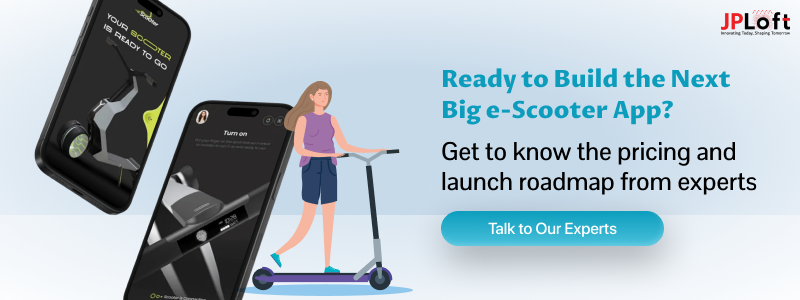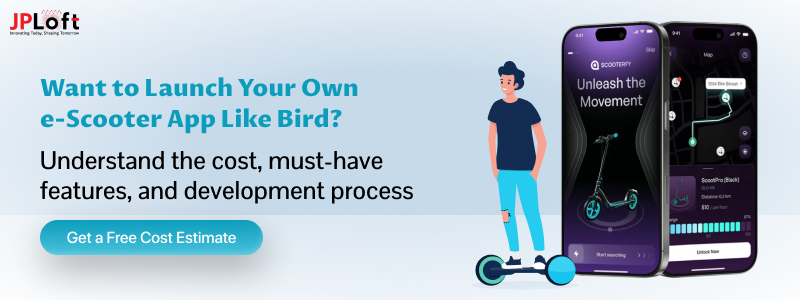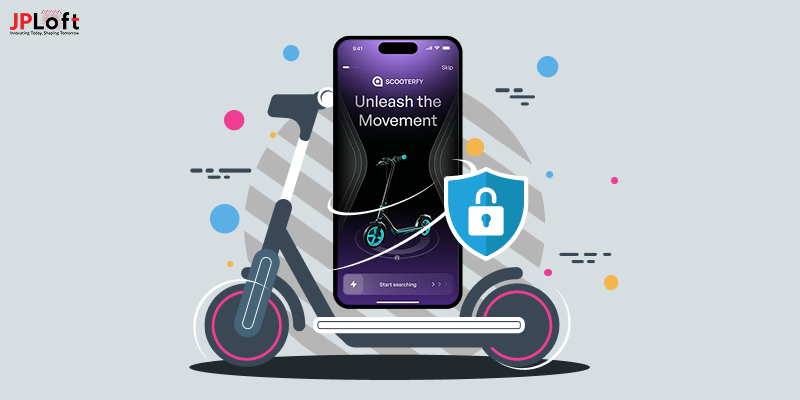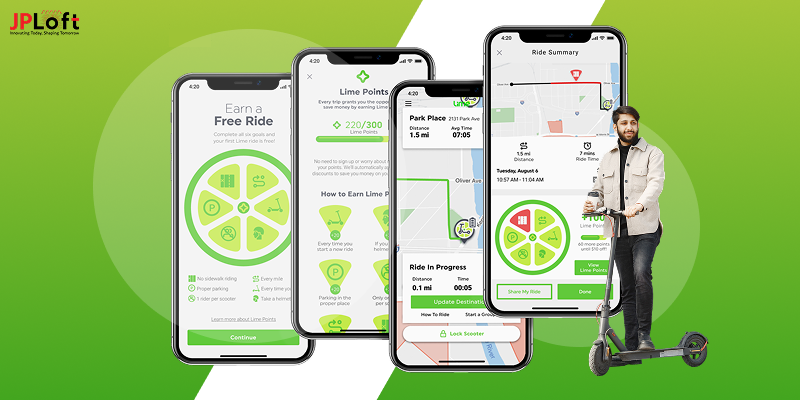In recent years, eScooter sharing platforms like Bird have revolutionized urban mobility, offering a convenient, eco-friendly, and affordable alternative to traditional transport.
With micro-mobility becoming a booming industry, entrepreneurs and startups are increasingly exploring the idea of building their scooter-sharing apps.
On average, the cost to build an app like Bird ranges between USD 25,000 and USD 355,000, depending on factors such as features, platform choice (iOS, Android, or both), design complexity, third-party integrations, and the location of the development team.
In this blog, we will break down the cost structure, discuss the core features required, explore the factors that influence the budget, and provide actionable tips to optimize your app development expenses, helping you turn your Bird-like app idea into a profitable business.
Key Takeaways
Developing a Bird-like e-scooter app typically costs USD 25,000 to USD 355,000, depending on complexity, features, and development approach.
An MVP with core features can be developed for USD 25,000 – USD 50,000, helping startups launch faster and at lower risk.
Core features of the Bird app include GPS tracking, QR-based unlocking, secure payments, ride history, battery indicators, push notifications, and an admin dashboard.
Development time of a Bird-like app can take 3–6 months for standard features, extending to 10+ months for advanced functionalities.
Cost-Saving Tips: Start with an MVP, choose cross-platform development, use pre-built solutions, and leverage cloud infrastructure.
Monetization strategies include pay-per-ride, subscriptions, franchise partnerships, in-app ads, data monetization, and AI-driven enhancements.
Working with JPLoft, an experienced eScooter development company, could support your ambition to launch an eScooter app company similar to Bird.
About Bird: Ride Electric
Bird is a leading micro-mobility company founded in 2017, headquartered in Santa Monica, California. Its eScooter app has transformed short-distance urban travel by offering an eco-friendly, affordable, and convenient alternative to cars and public transport.
The Bird app enables users to locate, unlock, and ride eScooters intracity. The simple process of downloading the app, creating an account, locating a nearby scooter using GPS, scanning the QR code to unlock, and starting to ride. Once the trip ends, riders can park the eScooter at a designated spot and end the ride in the app.
Key Features:
-
Real-time scooter tracking to find the closest available ride.
-
QR code unlocking for fast and contactless access.
-
Integrated payment options, supporting credit/debit cards and mobile wallets.
-
Ride history and cost tracking for transparency.
-
Battery level indicators so users can select scooters with sufficient charge.
Bird’s app also integrates with IoT (Internet of Things) hardware inside the scooters, enabling remote lock/unlock functionality, GPS monitoring, and battery management. It is available on both iOS and Android platforms and operates in hundreds of cities globally.
One of the Bird’s biggest appeals is its commitment to sustainability. By replacing short car trips with electric scooter rides, Bird helps reduce CO2 emissions and traffic congestion. The company has also implemented recycling programs and uses swappable batteries to extend scooter lifespan.
What is the Benefit of Investing in an eScooter App like Bird?
Before jumping to what's the cost to build an app like Bird, let's first understand why investing in an eScooter app like Bird offers several benefits:
A] High Market Demand
The global e-scooter sharing market is projected to reach USD 40 billion by 2030, driven by urbanization and the need for quick, affordable mobility solutions. Major cities are adopting micromobility to reduce traffic congestion, with some reporting a 15–20% drop in car trips after scooter-sharing programs were introduced.
B] Eco-Friendly Business Model
E-scooters produce up to 45% fewer CO₂ emissions than cars for short trips. Bird alone claims its riders have collectively offset millions of kilograms of carbon emissions by replacing car journeys. This aligns perfectly with government climate action plans and green city initiatives.
C] Recurring Revenue Potential
With pricing models such as $1 for unlocking and $0.15–$0.25 per minute of ride, businesses generate consistent income per ride. Industry data shows that each actively used scooter can generate USD 1,500–USD 3,000 per year, depending on the city and utilization rates.
D] Scalable Operations
Once the app, fleet, and backend systems are set, expansion to new cities requires minimal changes. Bird operates in 350+ cities worldwide, proving the scalability of this model.
E] Tech-Driven Efficiency
IoT integration enables remote locking/unlocking, GPS tracking, and predictive maintenance, reducing theft and downtime. AI can forecast peak demand hours and locations, improving fleet allocation and maximizing revenue.
F] Government Support
Many cities offer subsidies, dedicated scooter lanes, and operational licenses for micro-mobility providers. Paris, for example, invested over USD 175 million into cycling and scooter infrastructure between 2021–2025.
G] Lower Operating Costs Compared to Ride-Hailing
Unlike ride-hailing, there are no driver salaries, just maintenance, charging, and redistribution expenses. Operational costs can be 30–40% lower than traditional transport businesses.
H] Attractive to Investors
The micro-mobility sector has attracted over USD 5 billion in venture funding in the last 5-7 years. Companies like Bird and Lime have achieved multi-billion-dollar valuations within a few years of launch.
I] Brand Differentiation
By adding custom features like rewards, gamification, or local merchant partnerships, startups can stand out from competitors. For example, Spin partnered with universities to offer student-only discount programs, boosting adoption.
J] Positive Public Perception
Supporting sustainable transport builds trust and loyalty. Surveys show 70% of urban residents view micro-mobility positively, associating it with cleaner air, quieter streets, and more accessible city travel.
These factors combine to make the cost to build an app like Bird worth the investment, giving opportunities with the potential for sustainable and scalable returns in a futuristic urban mobility sector.
Having explored what makes Bird one of the best eScooter apps, it's now time to dive into the key features that would make an app like Bird even more effective and user-friendly.
Understanding these essential features is crucial for creating a seamless experience for riders and operators and avoiding the challenges of eScooter app development.
Features to Include in an App Like Bird
To create an eScooter app like Bird, your app should offer a smooth, intuitive, and reliable experience for both riders and administrators.
The table below represents a breakdown of key features to include in a Bird-like app, which directly impacts the overall cost to develop an app like Bird:
|
Component |
Purpose |
Key Functions |
|
User Registration & Profile Management |
Allows riders to sign up, verify their account, and manage personal details. |
|
|
Real-Time Vehicle Tracking (GPS Integration) |
Enables users to locate the nearest available scooters on the map. |
|
|
QR Code Scanning for Unlocking |
Offers quick and contactless scooter unlocking. |
|
|
Ride Booking & Start/Stop Functionality |
Let users easily initiate and end rides. |
|
|
Payment Gateway Integration |
Facilitates secure and flexible transactions. |
|
|
Ride History & Analytics |
Provides users with insights into past rides and expenses. |
|
|
Push Notifications & Alerts |
Keeps riders informed about offers, booking confirmations, or scooter availability. |
|
|
Battery Status & Range Indicator |
Helps riders choose scooters with enough charge for their trip. |
|
|
Admin Dashboard |
Allows operators to manage the fleet and monitor performance. |
|
|
IoT Integration for Vehicle Control |
Links the scooter hardware with the app for remote control and monitoring. |
|
For a basic MVP: GPS tracking, QR-based unlocking, real-time availability, and a payment gateway.
The combination of these eScooter app features will help you build a robust, secure, and accessible eScooter sharing platform, ensuring both user satisfaction and operational efficiency.
Now that we’ve covered the essential features that make an app like Bird both functional and user-friendly, it’s time to take a look at the cost to develop an app like Bird from scratch.
What's the Cost to Build an App Like Bird?
The cost to develop a Bird clone typically ranges from $25,000 to $355,000, depending on the app's complexity, features, platform choice, and development stage.
The development cost of an eScooter app involves several major components, each with its own development and cost implications.
Here’s a detailed breakdown by component and development stage, including typical feature sets and technological elements, giving you a detailed understanding of the cost to launch an eScooter app like Bird:
|
Component |
Estimated Price (USD) |
Features/Tasks |
|
Market Research & Planning |
$5,000 – $15,000 |
Analyzing the target market, competitors, and local regulations. |
|
UI/UX Design |
$3,000 – $10,000 |
Designing app interfaces, user flows, custom branding, and usability |
|
Front-End Development |
$10,000 – $50,000 |
Building the client-side part of the app (user interface, interaction logic) |
|
Back-End Development |
$20,000 – $70,000 |
Server-side coding, databases, API development, user management, real-time tracking |
|
Platform Development |
$50,000 – $100,000+ |
Developing native apps for iOS and Android or cross-platform solutions, often per-platform cost |
|
Third-Party Integrations |
$2,000 – $10,000 |
Payment gateways (Stripe, PayPal), map services (Google Maps), notifications |
|
Testing and Quality Assurance |
$2,500 – $5,000 |
Manual and automated testing on devices for bugs, UX, and performance |
|
Deployment |
Around $100/year (for App Store) + minor deployment costs |
Launching on app stores (fees + server setup) |
|
Maintenance & Updates |
15–20% of the initial development cost per year |
Ongoing bug fixes, new features, server maintenance, and AI model retraining |
Each component’s cost to create an app like Bird can fluctuate based on feature complexity, regional developer rates, use of ready-made solutions or custom code, and hardware integration depth.
1. Breakdown of Cost to Develop a Bird Clone by Functionality and Features:
While the overall cost to develop an eScooter app like Bird estimates gives you a general idea, breaking down expenses by specific functionality helps you prioritize features and control your budget:
|
Functionality/Feature |
Estimated Cost Range (USD) |
Details |
|
User Registration & Authentication |
$1,500 – $3,000 |
Email, phone, or social login; profile setup. |
|
Real-Time GPS Tracking |
$3,000 – $6,000 |
Locate scooters, display routes, Google Maps. |
|
QR Code Scanning & Unlocking |
$2,500 – $5,000 |
Connects with the IoT lock system for scooter access. |
|
Ride Booking & Start/Stop |
$2,000 – $4,000 |
Start ride, end ride, calculate trip time & cost. |
|
Payment Gateway Integration |
$2,500 – $5,000 |
Credit/debit cards, mobile wallets, subscription options. |
|
Battery Status & Range Indicator |
$1,500 – $3,000 |
Shows charge level and estimated travel distance. |
|
Push Notifications & Alerts |
$1,000 – $2,500 |
Ride updates, promotions, low-battery alerts. |
|
Ride History & Analytics |
$2,000 – $4,000 |
Past trips, cost summaries, downloadable invoices. |
|
Referral & Rewards System (optional) |
$1,500 – $3,000 |
Invite friends, earn ride credits. |
|
Admin Dashboard (Web Panel) |
$5,000 – $12,000 |
Fleet management, payments, analytics, maintenance logs. |
|
IoT Hardware & Integration |
$5,000 – $15,000 |
GPS, lock/unlock, anti-theft alerts. |
|
AI Features (optional advanced) |
$5,000 – $20,000 |
Predictive maintenance, demand forecasting, route optimization. |
|
Testing & Quality Assurance |
$3,000 – $7,000 |
Manual + automated testing, bug fixing. |
|
Project Management |
$2,000 – $5,000 |
Agile sprint planning, communication, delivery tracking. |
These estimate cost to develop an app like Bird comes from recent development industry data of e-scooter apps similar to the Bird platform.
The typical development time to build an AI app like Bird ranges from 3 to 6 months, depending mainly on the app complexity, feature set, and customization requirements.
However, adding extensive advanced features such as real-time analytics, AI-powered functionalities, IoT integrations, and a robust backend infrastructure can extend the timeline to 10 months or more, also impacting the cost to build an app like Bird.
2. App Complexity with Total Cost to Build a Bird Clone:
A) Basic App:
-
Features: Minimum Viable Product (MVP) with core features like user registration, scooter rental, payment processing, and basic navigation functionalities.
-
Development Time: 2 to 4 months
-
Estimated Cost in USD: $25,000 – $50,000
B) Intermediate App:
-
Features: Expanded features like ride tracking, user profiles, customer support, real-time GPS, and basic analytics to enhance the user experience.
-
Development Time: 3 to 6 months
-
Estimated Cost in USD: $50,000 – $100,000
C) Advanced App:
-
Features: Advanced UI/UX design, integration with third-party services (maps APIs, payment gateways), detailed analytics, and reporting capabilities.
-
Development Time: 6 to 10 months
-
Estimated Cost in USD: $100,000 – $200,000
D) Comprehensive App:
-
Features: Full-scale app features like extensive customization, IoT integration for scooter monitoring and maintenance, and smart backend infrastructure for scalability and system robustness.
-
Development Time: 10 months+
-
Estimated Cost in USD: $150,000 – $355,000
These timelines and cost to create an app like Bird can vary based on the development team’s location, experience, and size, as well as the project scope management.
3. Additional/Optional Components:
-
AI/Machine Learning: Predictive analytics for fleet management and user personalization.
-
Advanced Analytics: Custom reports, operational insights.
-
Multilingual Support: Wider user accessibility.
-
Marketing and Promotions Module: Targeted campaigns, offer management.
-
Customer Support Chat/Helpline: In-app helpdesk or chatbot.
Bird clone app development cost structure allows businesses and startups to start lean with an MVP, plan their budget, and scale features over time as the app grows. Updating the app as per user feedback and funding permits, optimizing investment effectively.
After knowing how much does it cost to develop an app like Bird, let’s dive deeper into the specific factors that can influence these development expenses. From development complexity to escooter app design choices, these elements play a crucial role in determining the final price tag.
Factors Impacting the Cost to Create an App like Bird
Create an app like Bird involves diverse cost factors, with AI integration increasingly shaping budgets and capabilities. The total cost to create an app like Bird is also influenced by several other variables. Understanding these factors will help you plan your budget more efficiently and prioritize features based on your business goals.
► App Complexity and Feature Set
The number and sophistication of features directly influence development hours and, in turn, the cost. A basic cost to develop an eScooter app like Bird or MVP will be significantly less than a feature-rich app with advanced analytics, AI-powered predictions, and IoT integrations.
► AI and Machine Language Integration
Following up with the latest eScooter app trends, incorporating AI can elevate the app’s functionality and user engagement. But AI features demand additional development time, specialized expertise, addition in cost to create an app like Bird and ongoing training of algorithms, which increases both initial and maintenance costs.
► Development Team Location and Expertise
Developer rates vary widely depending on the region and expertise of the individual. Hire dedicated developers from North America can cost around USD 80 to 150 per hour; Western European developers charge USD 60 to 120 per hour; Eastern European developers charge USD 40 to 80 per hour.
► Third-Party API and SDK Integrations
Many features (maps, payments, SMS, push notifications) rely on third-party services like Google Maps, Stripe, or Twilio. While integration is faster than building from scratch, API subscription or usage fees add to operational costs.
► Scalability and Infrastructure Needs
If you anticipate rapid growth, your backend must handle high user loads without downtime. Setting up scalable cloud infrastructure (AWS, Azure, Google Cloud) costs more initially but avoids expensive migrations later.
► Post-Launch Maintenance and Updates
The initial launch is just the start; regular updates, bug fixes, and new feature rollouts are necessary to stay competitive. Maintenance typically costs 15–20% of the initial cost to build a Bird clone annually.
Implementation of AI can both increase the initial cost to develop an eScooter app like Bird (due to specialized tech, data, and expertise needs) and reduce overall expenses (via automation, faster prototyping, and smarter testing). Careful planning and scope control are vital for a successful, future-proof Bird-like app.
It's now time to shift focus to strategies that can help reduce these expenses. By making smart decisions throughout the development process and hiring an AI app development company, you can still create a high-quality app while keeping the cost to make an app like Bird in check.
How to Reduce the Cost to Make an App Like Bird?
Partnering with the top mobile app development companies in the USA for building an app like Bird can be a significant investment, but there are smart strategies to control expenses without compromising quality or user experience.
Here’s how you can optimize the cost to develop an eScooter app like Bird:
1. Start with an MVP (Minimum Viable Product)
Launch with only the most essential features, such as user registration, GPS tracking, QR unlocking, and payment integration. Skip advanced features for later updates.
Cost Benefits: Reduces initial development hours and allows you to test your business model before committing to a full-scale product.
2. Outsource Development to Cost-Effective Regions
Hire skilled developers from regions with lower hourly rates (e.g., Eastern Europe).
Cost Benefits: Development costs can drop by 40–60% compared to North American or Western European rates, without sacrificing quality if you vet the team carefully.
3. Prioritize Features based on ROI
Focus on features that directly impact user acquisition and retention in the early stages.
Cost Benefits: Avoids wasting budget on “nice-to-have” features that don’t generate revenue in the short term.
4. Leverage Cloud Services Instead of Custom Infrastructure
Use AWS, Google Cloud, or Azure for hosting, storage, and database needs instead of building your own servers.
Cost Benefits: Pay-as-you-go models reduce upfront infrastructure investment.
5. Adopt Agile Development
Work in sprints, test regularly, and adjust the scope based on user feedback.
Cost Benefits: Prevents expensive rework and ensures only valuable features are built.
6. Plan for Scalability Early
Even when starting small, choose an architecture that can scale without complete overhauls.
Cost Benefits: Avoids expensive migrations or system rebuilds as your user base grows.
Launching a mobile app design like Bird and scaling feature by feature is the single best way to control both risk and total Bird like app development cost. Smart technology choices (cross-platform, open source, outsourcing) and strict budgeting keep expenditures in check while laying a foundation for the future growth of the business.
Let’s now explore some effective monetization strategies that can help you turn up your business revenue and cover up the cost to build an app like Bird.
Monetization Strategies to Make an App Like Bird
Building an app similar to Bird involves a mix of direct and indirect revenue streams that maximize both customer engagement and overall profitability.
Below are proven eScooter app monetization strategies used by various other successful eScooter app companies like Bird:
► Pay-Per-Ride Model
Unlock Fee + Per-Minute Charge: Users pay a fixed fee to unlock a scooter and then a variable fee per minute or mile traveled. This is Bird's core revenue source and ensures steady cash flow.
Dynamic Pricing: Prices can adjust based on demand, time of day, and location, optimizing revenue during busy periods or in popular zones.
► Subscription Plans and Memberships
Monthly/Weekly/Annual Passes: Frequent riders can buy plans that offer discounted or unlimited rides for a recurring fee, improving loyalty and ensuring predictable revenue.
Corporate or Campus Subscriptions: Target businesses, offices, or universities with discounted fleet access for employees or students.
► Platform/Franchise Partnerships
Fleet Operators: Allow local entrepreneurs or businesses to manage a fleet using your technology and branding in exchange for setup fees or a service commission. Bird also charges operators a service fee.
► Referral and Loyalty Programs
Reward Sharing: Encourage users to invite friends with referral bonuses, free rides, or app credits.
Promo Codes: Distribute discounts to boost customer retention, re-engagement, and app usage.
► Value-Added Services
In-App Purchases: Sell accessories (helmets, gloves) or merchandise targeted at riders.
Smart Parking Solutions: Partner with parking lots or garages for premium parking, charging extra fees for reserved spots.
► Data Monetization
Analytics Services: Provide anonymized mobility data or insights to city planners, event organizers, or local authorities in exchange for a fee (with user consent and privacy compliance).
► Brand Partnerships and Merchandise
Co-branded Promotions: Team up with brands for exclusive campaigns or limited-edition scooter wraps.
Event Sponsorships: Offer fleets for major local events for a fee or brand exposure.
eScooter business models with smart pricing, predictive maintenance, and personalized promos help increase both monetization and customer satisfaction.
A multi-channel approach not only ensures profitability but also positions your Bird-like e-scooter app ideas for sustainable growth in a competitive market.
Your App, Our Expertise: Partner with JPLoft
At JPLoft, a professional eScooter app development company turns bold mobility ideas into high-performing, market-ready apps. If you are envisioning your own eScooter sharing platform like Bird, our expert team has the skills, tools, and industry insights to bring it to life.
With years of experience in IoT integration, AI-driven analytics, and scalable app architecture, we understand the unique challenges of micro-mobility solutions. From real-time GPS tracking and QR code unlocking to secure payment gateways and admin dashboards, we deliver every feature you need to ensure a seamless experience for both riders and operators.
Our development process is end-to-end, from concept validation and UI/UX design to backend engineering, hardware integration, and post-launch support. We follow Agile methodologies, ensuring faster delivery, flexibility for changes, and optimal cost control.
Your idea has the potential to change the way people move. Let’s build the next big eScooter success story together. Partner with JPLoft, and watch your vision ride into reality!
Conclusion
Building an app like Bird is not just about replicating its features. But it's about creating a seamless, scalable, and user-friendly platform that meets the growing demand for eco-friendly urban mobility. With development costs typically ranging from USD 25,000 to USD 300,000, your final budget will depend on factors such as app complexity, platform choice, AI integration, design quality, and IoT hardware requirements.
The eScooter sharing industry is expanding rapidly, fueled by rising environmental awareness, government support for green initiatives, and the convenience such services bring to city residents. While the initial investment may seem significant, the potential for recurring revenue, brand recognition, and long-term scalability makes it a promising venture.
By combining innovative features, strong operational planning, and sustainable practices, you can position your app to compete effectively in the micromobility market.
FAQs
The cost of developing an e-scooter sharing app like Bird usually falls between $25,000 and $355,000. The complexity of your design, platform choices, and the development team's expertise also greatly influence the final cos
Several elements directly affect the pricing of such an app, including the feature set (core vs. advanced), complexity of IoT integration for scooters, data security compliance, custom branding, AI capabilities like predictive analytics, and platform type (iOS, Android, or cross-platform).
An MVP version of a Bird-style app, focusing only on essential functions such as user registration, scooter location tracking, unlocking via QR codes, ride monitoring, and payment processing, typically costs between $25,000 to $50,000. This is the most cost-effective approach for startups.
Yes, AI features such as dynamic pricing, predictive maintenance, and rider behavior-based route optimization can add $20,000 to $100,000+ to the budget. This is because AI development requires specialized data collection, training models, and ongoing computational resources.
Native development for iOS and Android separately can cost $19,000 – $35,000 per platform, leading to higher total expenses. In contrast, using cross-platform frameworks like Flutter or React Native can reduce development time and expenses by around 30 – 40%. Cross-platform is ideal for faster market entry.













Share this blog